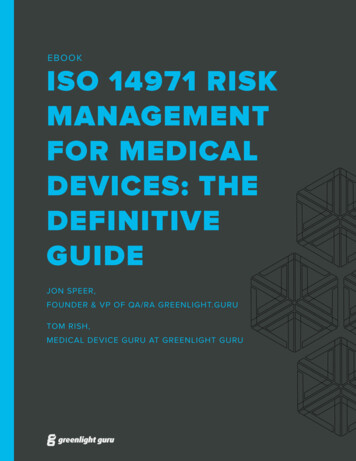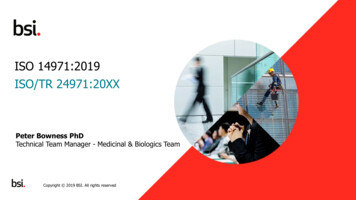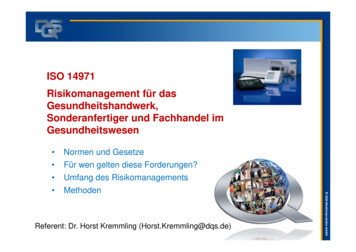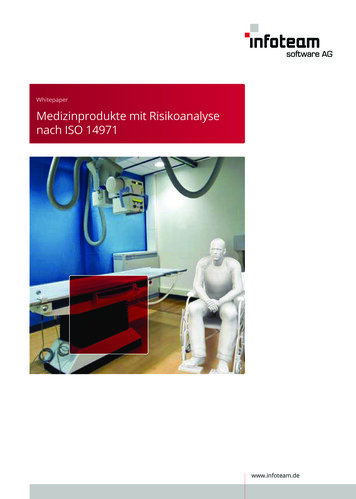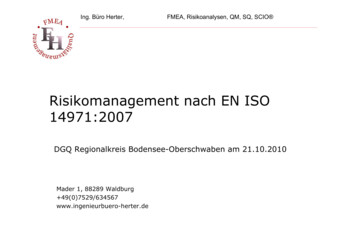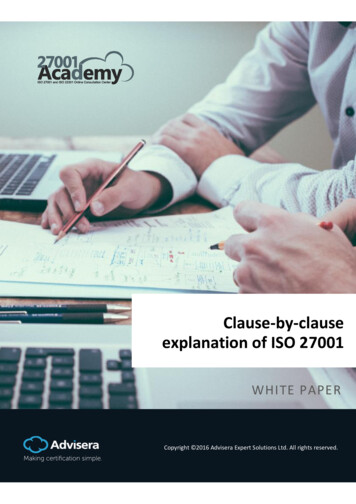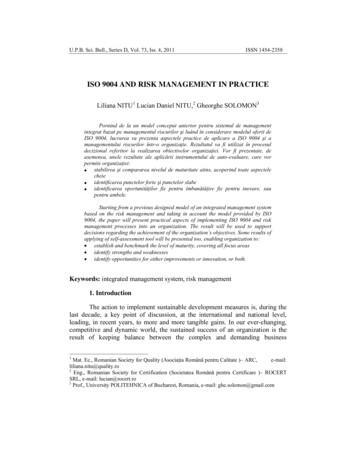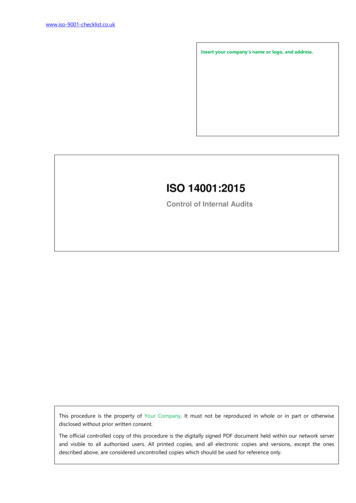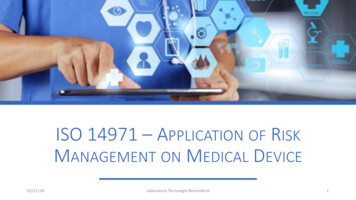
Transcription
ISO 14971 – APPLICATION OF RISKMANAGEMENT ON MEDICAL DEVICE02/11/19Laboratorio Tecnologie Biomediche1
ISO 14971 – TERMS AND DEFINITIONSHarmHazardHazard situationSeveritySafety02/11/19Physiological injury or damage to the health of people, or damage to property or theenvironmentPotential source of harmCircumstance in which people, property, or the environment are exposed to one ormore hazard(s)Measure of the possible consequences or impact of a hazard. Severity is onecomponent of risk.Freedom from unacceptable riskLaboratorio Tecnologie Biomediche2
RISK FOR ISO 14971RISK IS DEFINED AS THE COMBINATION OF .The frequencyor likelihoodharm will occur02/11/19The extent of itsimpact orconsequencesTheprobability ofOCCURRENCE ofharmLaboratorio Tecnologie BiomedicheSEVERITY ofthe harm3
WHAT YOU WILL GAIN FORM THIS GUIDEISO 14971 provides a thorough explanation of relevant terms and definitions. Andthe standard defines a RISK MANAGEMENT process.In addition to ISO 14971, there are several other key medical device industrystandards requiring risk management:The partial list includes: IEC 60601 - is a series of technical standards for the safety and essentialperformance of medical electrical equipment. IEC 62366 - Application of usability engineering to medical devices ISO 10993 - series of standards for evaluating the biocompatibility of medicaldevices ISO 13485 - Medical devices - Quality management systems - Requirements forregulatory purposes. It represents the requirements for a comprehensive qualitymanagement system for the design and manufacture of medical devices02/11/19Laboratorio Tecnologie Biomediche4
A BRIEF OVERVIEW OF THE STANDARD & ANNEXESToday there are two versions of ISO 14971 – both likely to impact you in some way: ISO 14971:2007 and EN ISO 14971:2012The EN version is applicable if you are selling medical device in Europe.In both cases, the abstract describing the standard is the same:“ISO 14971 is a key standard specifying a process for a manufacturer to identify the hazardsassociated with medical devices, including in vitro diagnostic (IVD) medical devices, toestimate and evaluate the associated risks, to control these risks, and to monitor theeffectiveness of the controls. The requirements of this standard are applicable to all stagesof the life-cycle of a medical device.”02/11/19Laboratorio Tecnologie Biomediche5
ISO 14971- GENERAL REQUIREMENTS FOR RISKRisk evaluationRisk controlEvaluation of overall residualrisk acceptabilityRisk ManagementRisk analysisRisk AssessmentMANAGEMENTRisk management reportProduction and post-productioninformation02/11/19Laboratorio Tecnologie Biomediche6
THE RISK MANAGMENT STEPS ACCORDING TOISO 14971 Risk analysis Identification of subject (product, process, decision)Identification of characteristics related to safetyIdentification of hazardsEstimation of risk(s) for each hazardous situation Risk evaluation Risk control Implementation of risk control measure(s) Residual risk evaluation Evaluation of overall residual risk acceptability02/11/19Laboratorio Tecnologie Biomediche7
ISO 14971 – RISK ANALYSISSystematic use of available information to identify hazards and toestimate the risk.1. Intended use and identification of characteristics elated to thesafety of medical device – ANNEX C2. Identification of hazards - ANNEX E3. Estimation of the risk(s) for each hazardous situation02/11/19Laboratorio Tecnologie Biomediche8
PRODUCT DESCRIPTIONIntended use and identification of characteristics related to the safetyof medical device – ANNEX C description, part number, important subassemblies (functionalgroups) Intended use02/11/19Laboratorio Tecnologie Biomediche9
ANNEX C - CHECKLIST EXAMPLE C.2.1 What is the intended use and how is the medical device to be used? 2.1.1 What is the medical device’s role relative to: 2.2.1.1 Diagnosis, prevention, monitoring, treatment or alleviation of disease; 2.2.1.2 Compensation for injury or handicap; 2.2.1.3 Replacement or modification of anatomy, or control of conception? 2.1.2 What are the indications for use (e.g. patient population)? 2.1.3 Does the medical device sustain or support life? 2.1.4 Is special intervention necessary in the case of failure of the medical device? C.2.2 Is the medical device intended to be implanted? Factors that should be considered include: 02/11/192.2.1 The location of implantation;2.2.2 The characteristics of the patient population;2.2.3 Age;2.2.4 Weight;2.2.5 Physical acutivity;2.2.6 The effect of ageing on implant performance;2.2.7 The expected life time of the implant;2.2.8 The reversibility of the implantationLaboratorio Tecnologie Biomediche10
IDENTIFICATION OF HAZARDSIdentification of hazards ANNEX E WHAT? Known and foreseeable Normal use and first fault condition Technical and user related HOW? 02/11/19Use of the checklist in the norm (Appendix E)Review of historyOpinion of expertsState of the artTest (challenging tests)Non compliance to (harmonised) standardsLaboratorio Tecnologie Biomediche11
02/11/19Laboratorio Tecnologie Biomediche12
02/11/19Laboratorio Tecnologie Biomediche13
ESTIMATION OF THE RISKSEstimation of the risk(s) for each hazardous situationThe concept of risk is the combination of the following two components: the probability of occurrence of harm; the consequences of that harm, i.e., how severe it might be.Risk Occurrence x SeverityRisk estimation should examine, for example: 02/11/19the initiating event or circumstance (see E.3);the sequence of events that could lead to a hazardous situation occurring;the likelihood of such a situation arising;the likelihood that the hazardous situation leads to harm;the nature of the harm that could result.Laboratorio Tecnologie Biomediche14
ASSESSMENT OF SEVERITY (S) AND OCCURRENCE (O)Annex D Method: Qualitative Semi-quantitive Focus: Systematic faults, first faults Events02/11/19Laboratorio Tecnologie Biomediche15
EXAMPLE OF OCCURRENCE ESTIMATIONQualitativeProbability of occurrence ODescription of hazard/failure occurrenceIndexVery highThe event is almost sure5HighMany cases in the evaluated period4ModerateSome cases in the evaluated period3LowA few cases in the evaluated period2RemotePotential hazard or failure, no known cases1QuantitativeProbability of occurrence ORange of occurrenceIndexFrequent 10-35Probable 10-3 and 10-44Occasional 10-4 and 10-53Remote 10-5 and 10-62Improbable 10-6102/11/19Laboratorio Tecnologie Biomediche16
EXAMPLE OF OCCURRENCE ESTIMATIONQualitative: gives a description of probability range Index associated to each range to simplify Risk Index evaluation Based on historical data, evaluated by field experts Past production information – State of the art, literatureQuantitative: gives estimated ranges Index associated to each range to simplify Risk Index evaluation: Based on data from: Modellization Production data Evaluation of statistics on past defect data02/11/19Laboratorio Tecnologie Biomediche17
SEVERITY OF THE HARMMeasure of the possible outcome and consequences of a hazard Estimating the severity: estimating consequences of a failure, the nature of harm that may arise the involvement of all stakeholders, in order of criticality02/11/19Laboratorio Tecnologie Biomediche18
EXAMPLE OF SEVERITY LEVELQualitativeSeverity SDescription of harmIndexCatastropheResults in patient death5CriticalResults in permanent impairment or life-threatening injury4SeriousResults in injury or impairment requiring professional medical intervention3MinorResults in temporary injury or impairment not requiring professional medical intervention2NegligibleInconvenience or temporary discomfort102/11/19Laboratorio Tecnologie Biomediche19
ISO 14971 – QUALITATIVE RISK MATRIXSeverityProbability hic12345Very 810Remote11234502/11/19Laboratorio Tecnologie Biomediche20
ISO 14971 – SEMI-QUANTITATIVE RISK MATRIXSeverityProbability boratorio Tecnologie Biomediche21
ISO 14971 - TABLEHazardHazard situationHarmOccuranceSeverityRi (SxO)R1 R2 R3 R4 02/11/19Laboratorio Tecnologie Biomediche22
ISO 14971 – RISK MATRIX02/11/19Laboratorio Tecnologie Biomediche23
ISO 14971 - RISK EVALUATION AND RISKACCEPTABILITYRi S x OFollowing the examples above Ri 4 acceptable 5 Ri 12 requires further evaluation Ri 13 not acceptable02/11/19Laboratorio Tecnologie Biomediche24
ISO 14971 – QUALITATIVE RISK EVALUATIONSeverityProbability hic12345Very 810Remote11234502/11/19Laboratorio Tecnologie Biomediche25
ISO 14971 – SEMI-QUANTITATIVE RISK EVALUATIONSeverityProbability boratorio Tecnologie Biomediche26
ISO 14971 - TABLEHazardHazard situationHarmOccuranceSeverityRi (SxO)R1 R2 R3 R4 02/11/19Laboratorio Tecnologie Biomediche27
ISO 14971 - RISK CONTROLThe manufacturer must apply the following principles in the followingorder: eliminate or reduce risks as far as possible (inherently safe design andconstruction), where appropriate take adequate protection measures includingalarms if necessary, in relation to risks that cannot be eliminated, inform users of the residual risks due to any shortcomings of theprotection measures adopted.02/11/19Laboratorio Tecnologie Biomediche28
IDENTIFICATION OF RISK CONTROL MEASURESUsed to reduce risk (either occurrence or severity or both)Risk control methods, in the preferred order of: Safe design Alarms and protections Advertences and warnings02/11/19Laboratorio Tecnologie Biomediche29
IMPLEMENTATION OF RCMMeasure of RCM impact on lowering the Occurrence and/or Severity of anyharmIn the design Inherent design for safety – Design of protection measuresIn the manufacturing or quality control Process control Additional/ dedicated testingIn the final user training02/11/19Laboratorio Tecnologie Biomediche30
EXAMPLE OF RMC02/11/19Laboratorio Tecnologie Biomediche31
EXAMPLE OF RMC INDEX TABLERCM Index RDescriptionIndexNegligibleDesign: no control during design; harm not detected during manufacturing stepsAlarms and protections: not activated; harm not detectable during a routine checkWarning: no warnings foreseen in label1Very lowDesign: no control during design; harm may be detected by a 100% controlAlarms and protections: not activated; harm is detectable during a routine checkWarning: no warnings foreseen in label0.8LowDesign: no control during design; harm easily detected by a 100% controlAlarms and protections: not activated; harm is surely detected during a routine checkWarning: general warning foreseen in label0.6NormalDesign: QC test designed for harm detection at manufacturing steps; or characteristic isrendered less risky during design; harm may be detected by a sampling plan controlAlarms and protections: activated after a certain amount of timeWarning: normed warnings and symbols foreseen in label0.4HighDesign: characteristic is rendered safe at design step (design solution or process validaton)Alarms and protections: activated immediatelyWarning: detailed, evident warnings and symbols foreseen in label0.202/11/19Laboratorio Tecnologie Biomediche32
RISK AFTER RCMMeasures level of risk after the RCM is implemented and verifiedRiafter RixRKeep same levels for acceptability, for easiness of use (RCM Index is afraction when effective)If risk is higher, new RCM may be required and/or the RCM under evaluation may be discarded as not feasible02/11/19Laboratorio Tecnologie Biomediche33
FINAL TABLEHazard Hazard situationHarmOccuranceSeverityRi (SxO)RMCRMC indexRi afterR1 R2 R3 R4 02/11/19Laboratorio Tecnologie Biomediche34
ISO 14971 - OVERALL EVALUATION AND RISKAPPROVAL Set acceptable percentage of yellow risk in the analysis NO red risk should be accepted before the overall risk-benefitevaluationBenefit evaluation As compared to state of the art As per intended use and expected results As compared to the patient clinical state, life expectancy, quality oflife Usually is difficult to express in quantitative terms, relative to manyfactors02/11/19Laboratorio Tecnologie Biomediche35
INFUSION PUMP EXAMPLEHazardForeseeable Sequence of EventsHazard situationHarmOSRiElettromagnetic energy (ESD)Electrostatically charged patient touchesinfusion pumpFailure to deliver insulin unknownto patient with elevated bloodglucose levelMinor organdamage22R1 4Decreasedconsciousness34R2 12Coma, death55R3 25ESD causes pump and pump alarms tofailInsulin not delivered to patient02/11/19Laboratorio Tecnologie Biomediche36
INFORMATION FOR SAFETY02/11/19Laboratorio Tecnologie Biomediche37
INFUSION PUMP EXAMPLEHazardElettromagneticenergy(ESD)Foreseeable Sequence ofEventsElectrostatically chargedpatient touches infusion pumpESD causes pump and pumpalarms to failInsulin not delivered to patient02/11/19Hazard situationHarmOSRiRMCFailure to deliverinsulin unknown topatient with elevatedblood glucose levelMinor organdamage22R1 4Decreasedconsciousness34R2 12Coma, death35R3 15Informationfor safety –Electrostaticdischargealarms andwarningsLaboratorio Tecnologie BiomedicheRMCindexRafter0.20.42,4538
HAZARDS FOR INFUSION PUMPHazardous or potentially harmful situations for the generic infusion pumpcan be classified under the following categories1.2.3.4.5.6.7.8.Operational HazardsEnvironmental HazardsElectrical HazardsHardware HazardsSoftware HazardsMechanical Hazards (Physical Hazards)Biological and Chemical HazardsUse Hazards02/11/19Laborator
ISO 14971 –TERMSANDDEFINITIONS 02/11/19 Laboratorio Tecnologie Biomediche 2 Harm Physiological injury or damage to the health of people, or damage to property or the environment Hazard Potential source of harm Hazard situation Circumstance in which people, property, or the environment are exposed to one or more hazard(s) Severity Measure of the possible consequences or impact of a hazard.
